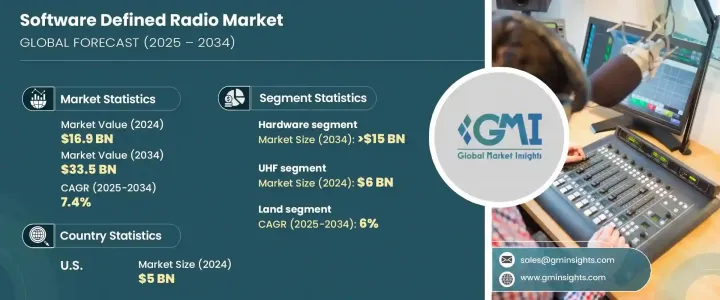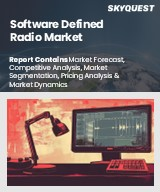
|
시장보고서
상품코드
1716526
세계의 SDR(Software Defined Radio) 시장 기회, 성장 촉진요인, 산업 동향 분석 및 예측(2025-2034년)Software Defined Radio Market Opportunity, Growth Drivers, Industry Trend Analysis, and Forecast 2025 - 2034 |
||||||
세계 SDR(Software Defined Radio) 시장은 2024년 169억 달러에 달했고, 2025년부터 2034년까지 연평균 복합 성장률(CAGR) 7.4%를 보일 것으로 예측됩니다.
SDR 기술은 통신 시스템의 유연성으로 인해 다양한 분야에서 점점 더 중요해지고 있습니다. 이 기술을 통해 군사, 통신, 공공 안전 및 기타 산업은 비용이 많이 드는 하드웨어 업그레이드에 의존하지 않고 소프트웨어로 주파수, 암호화 및 파형을 변경할 수 있습니다. 안전하고 상호 운용 가능한 통신에 대한 수요가 증가함에 따라 SDR은 군과 동맹국 간의 보다 효과적인 조정을 가능하게 하고, 중요한 데이터의 실시간 안전한 전송을 보장합니다. 또한, 전자전 및 전장 통신에 대한 지속적인 관심은 첨단 SDR 시스템에 대한 대대적인 투자로 이어지고 있습니다.

통신 분야에서 SDR은 네트워크의 미래를 보장하는 데 필수적이며, 5G 네트워크가 더 빠르고 낮은 지연을 요구하는 상황에서 SDR을 사용하면 통신 사업자는 소프트웨어 업데이트를 수행하고 하드웨어를 자주 교체할 필요가 없습니다. 마찬가지로 IoT, 스마트시티, 기업용 프라이빗 5G 네트워크와 같은 신기술에서 SDR의 역할은 네트워크 효율성 향상과 주파수 대역 활용 최적화를 가능하게 함으로써 더욱 중요해지고 있습니다.
| 시장 범위 | |
|---|---|
| 시작 연도 | 2024년 |
| 예측 연도 | 2025-2034년 |
| 시작 금액 | 169억 달러 |
| 예상 금액 | 335억 달러 |
| CAGR | 7.4% |
공공 안전 기관은 특히 자연재해, 테러 위협, 대규모 비상사태와 같은 심각한 환경에서 SDR 기술을 점점 더 많이 채택하고 있습니다. SDR은 실시간 주파수 및 암호화 조정을 통해 상호 운용성을 보장하고 재난 대응의 조정을 개선하여 상호 운용성을 보장하고 재난 대응의 조정을 개선함으로써 이 문제를 해결할 수 있습니다.
SDR 시장은 하드웨어, 소프트웨어, 서비스로 구분됩니다. 하드웨어 분야가 가장 큰 비중을 차지하며 전체 시장의 45% 이상을 차지하고 있으며, 2034년에는 150억 달러를 넘어설 것으로 예측되고 있습니다. 고성능 처리에 대한 요구가 높아지면서 FPGA(Field-Programmable Gate Arrays), DSP(Digital Signal Processor), RF 트랜시버 등의 하드웨어 컴포넌트는 다양한 산업에서 SDR 시스템의 성능 향상에 필수적인 요소입니다. 필수적입니다.
SDR 시장은 단파, 초단파, 초단파, 극초단파, 마이크로파, 밀리미터파 등 주파수 대역에 따라 세분화되며, UHF 부문이 우세하여 2024년 시장 규모는 60억 달러에 달했으며, UHF SDR 무전기는 다양한 지형에서 선명한 통신을 유지할 수 있기 때문에 군사, 응급 서비스, 상업용 용도에서 특히 유용하게 사용되고 있습니다.
플랫폼별로는 육상 부문이 가장 빠르게 성장하고 있으며, 연평균 6%의 성장률을 보일 것으로 예측됩니다. 이러한 성장의 원동력은 SDR 기술이 군사, 국방 및 공공 안전 통신 분야에서 SDR 기술의 채택이 증가함에 따라, SDR은 유연하고 안전하며 적응력이 뛰어난 통신을 가능하게 하여 복잡한 환경에서 효과적으로 운영하는데 필수적입니다. 북미는 세계 SDR 시장을 선도하고 있으며, 미국은 2024년 50억 달러의 매출을 달성했습니다.
목차
제1장 조사 방법과 조사 범위
제2장 주요 요약
제3장 업계 인사이트
- 업계 생태계 분석
- 공급업체 상황
- 하드웨어 프로바이더
- 소프트웨어 프로바이더
- 기술 제공업체
- 서비스 제공업체
- 최종 용도
- 이익률 분석
- 특허 분석
- 주요 뉴스와 이니셔티브
- 규제 상황
- 업계에 대한 영향요인
- 성장 촉진요인
- 업계의 잠재적 리스크와 과제
- 성장 가능성 분석
- Porter's Five Forces 분석
- PESTEL 분석
제4장 경쟁 구도
- 서론
- 기업의 시장 점유율 분석
- 경쟁 포지셔닝 매트릭스
- 전략 전망 매트릭스
제5장 시장 추산·예측 : 컴포넌트별, 2021년-2034년
- 주요 동향
- 하드웨어
- 컨버터
- 집적회로
- 디지털 신호 프로세서
- 소프트웨어
- 서비스
- 전문 서비스
- 매니지드 서비스
- 컨설팅 서비스
제6장 시장 추산·예측 : 무선기별, 2021년-2034년
- 주요 동향
- 적응형 무선
- 인지 무선 및 인텔리전트 무선
- 지상 기간 무선(TETRA) 시스템
- 공동 전술 무선 시스템
- 기타
제7장 시장 추산·예측 : 주파수대별, 2021년-2034년
- 주요 동향
- HF(단파)
- VHF(초단파)
- UHF(극초단파)
- SHF(마이크로파)
- EHF(밀리미터파)
제8장 시장 추산·예측 : 플랫폼별, 2021년-2034년
- 주요 동향
- 육상
- 항공
- 해군
- 우주
제9장 시장 추산·예측 : 최종 용도별, 2021년-2034년
- 주요 동향
- 군 및 방위
- 운송
- 정부기관
- 항공우주
- 통신
- 기타
제10장 시장 추산·예측 : 지역별, 2021년-2034년
- 주요 동향
- 북미
- 미국
- 캐나다
- 유럽
- 영국
- 독일
- 프랑스
- 이탈리아
- 스페인
- 러시아
- 북유럽
- 기타 유럽
- 아시아태평양
- 중국
- 인도
- 일본
- 한국
- 호주
- 뉴질랜드
- 동남아시아
- 기타 아시아태평양
- 라틴아메리카
- 브라질
- 멕시코
- 아르헨티나
- 기타 라틴아메리카
- 중동 및 아프리카
- 아랍에미리트(UAE)
- 사우디아라비아
- 남아프리카공화국
- 이스라엘
- 기타 중동 및 아프리카
제11장 기업 개요
- Thales Group
- L3Harris Technologies
- BAE Systems
- RTX Corporation
- Codan Radio Communications
- General Dynamics Mission Systems
- Ultra Electronics
- Rohde &Schwarz
- Elbit Systems
- Leonardo S.p.A.
- Northrop Grumman
- Anritsu Corporation
- Collins Aerospace
- Cubic Corporation
- DataSoft Corporation
- Ettus Research
- FlexRadio Systems
- NuRAN Wireless
- REDCOM Laboratories
- Syntony GNSS
The Global Software Defined Radio Market reached USD 16.9 billion in 2024 and is forecasted to grow at a CAGR of 7.4% from 2025 to 2034. SDR technology is becoming increasingly integral to various sectors due to its flexibility in communication systems. This technology allows military, telecommunications, public safety, and other industries to modify frequencies, encryption, and waveforms via software rather than relying on costly hardware upgrades. With the rising demand for secure, interoperable communication, SDR enables more effective coordination among military forces and allied nations, ensuring real-time, secure transmission of critical data. Additionally, the continued focus on electronic warfare and battlefield communication has led to significant investments in advanced SDR systems.

In the telecommunications sector, SDRs are essential for future-proofing networks. As 5G networks demand higher speeds and lower latency, SDR allows telecom providers to implement software updates, sidestepping the need for frequent hardware replacements. Similarly, SDR's role in emerging technologies like IoT, smart cities, and private 5G networks for businesses is becoming more significant, enabling enhanced network efficiency and optimized spectrum use.
| Market Scope | |
|---|---|
| Start Year | 2024 |
| Forecast Year | 2025-2034 |
| Start Value | $16.9 Billion |
| Forecast Value | $33.5 Billion |
| CAGR | 7.4% |
Public safety agencies are increasingly adopting SDR technology, particularly in high-stakes environments such as natural disasters, terrorist threats, and large-scale emergencies. In these critical situations, different response teams often struggle with communication due to incompatible radio systems. SDR solves this problem by enabling real-time frequency and encryption adjustments, ensuring interoperability, and improving disaster response coordination.
The SDR market is segmented into hardware, software, and services. The hardware segment holds the largest share, contributing over 45% of the total market, and is projected to surpass USD 15 billion by 2034. With growing demands for high-performance processing, hardware components such as field-programmable gate arrays (FPGAs), digital signal processors (DSPs), and RF transceivers are crucial for enhancing the performance of SDR systems in various industries.
The SDR market is also divided based on frequency bands, including high frequency, very high frequency, ultra-high frequency, super high frequency, and extremely high frequency. The UHF segment dominates, valued at USD 6 billion in 2024. UHF SDR radios are particularly valuable for military, emergency services, and commercial applications due to their ability to maintain clear communication across diverse terrains.
In terms of platforms, the land segment is growing the fastest, expected to expand at a CAGR of 6%. This growth is driven by the increasing adoption of SDR technology for military, defense, and public safety communications. SDR enables flexible, secure, and adaptable communication, which is vital for effective operations in complex environments. North America is leading the global SDR market, with the U.S. contributing USD 5 billion in revenue in 2024, largely due to robust military investments and advancements in telecommunications.
Table of Contents
Chapter 1 Methodology & Scope
- 1.1 Research design
- 1.1.1 Research approach
- 1.1.2 Data collection methods
- 1.2 Base estimates and calculations
- 1.2.1 Base year calculation
- 1.2.2 Key trends for market estimates
- 1.3 Forecast model
- 1.4 Primary research & validation
- 1.4.1 Primary sources
- 1.4.2 Data mining sources
- 1.5 Market definitions
Chapter 2 Executive Summary
- 2.1 Industry 3600 synopsis, 2021 - 2034
Chapter 3 Industry Insights
- 3.1 Industry ecosystem analysis
- 3.2 Supplier landscape
- 3.2.1 Hardware providers
- 3.2.2 Software providers
- 3.2.3 Technology providers
- 3.2.4 Service providers
- 3.2.5 End use
- 3.3 Profit margin analysis
- 3.4 Patent analysis
- 3.5 Key news and initiatives
- 3.6 Regulatory landscape
- 3.7 Industry impact forces
- 3.7.1 Growth drivers
- 3.7.1.1 Growing defense & military applications
- 3.7.1.2 Rise in wireless communication & 5G deployment
- 3.7.1.3 Advancements in cognitive radio & AI integration
- 3.7.1.4 Rising consumer awareness
- 3.7.2 Industry pitfalls & challenges
- 3.7.2.1 High development costs
- 3.7.2.2 Power consumption issues
- 3.7.1 Growth drivers
- 3.8 Growth potential analysis
- 3.9 Porter's analysis
- 3.10 PESTEL analysis
Chapter 4 Competitive Landscape, 2024
- 4.1 Introduction
- 4.2 Company market share analysis
- 4.3 Competitive positioning matrix
- 4.4 Strategic outlook matrix
Chapter 5 Market Estimates & Forecast, By Component, 2021 - 2034 ($Bn)
- 5.1 Key trends
- 5.2 Hardware
- 5.2.1 Converters
- 5.2.2 Integrated circuits
- 5.2.3 Digital signal processors
- 5.3 Software
- 5.4 Services
- 5.4.1 Professional services
- 5.4.2 Managed services
- 5.4.3 Consulting services
Chapter 6 Market Estimates & Forecast, By Radio, 2021 - 2034 ($Bn)
- 6.1 Key trends
- 6.2 Adaptive Radio
- 6.3 Cognitive Radio/ intelligent radio
- 6.4 Terrestrial trunked radio (TETRA) system
- 6.5 Joint tactical radio systems
- 6.6 Others
Chapter 7 Market Estimates & Forecast, By Frequency Band, 2021 - 2034 ($Bn)
- 7.1 Key trends
- 7.2 HF (High Frequency)
- 7.3 VHF (Very High Frequency)
- 7.4 UHF (Ultra High Frequency)
- 7.5 SHF (Super High Frequency)
- 7.6 EHF (Extremely High Frequency)
Chapter 8 Market Estimates & Forecast, By Platform, 2021 - 2034 ($Bn)
- 8.1 Key trends
- 8.2 Land
- 8.3 Airborne
- 8.4 Naval
- 8.5 Space
Chapter 9 Market Estimates and Forecast, By End Use, 2021 - 2034 ($Bn)
- 9.1 Key trends
- 9.2 Military & defense
- 9.3 Transportation
- 9.4 Government
- 9.5 Aerospace & aviation
- 9.6 Telecommunication
- 9.7 Others
Chapter 10 Market Estimates & Forecast, By Region, 2021 - 2034 ($Bn)
- 10.1 Key trends
- 10.2 North America
- 10.2.1 U.S.
- 10.2.2 Canada
- 10.3 Europe
- 10.3.1 UK
- 10.3.2 Germany
- 10.3.3 France
- 10.3.4 Italy
- 10.3.5 Spain
- 10.3.6 Russia
- 10.3.7 Nordics
- 10.3.8 Rest of Europe
- 10.4 Asia Pacific
- 10.4.1 China
- 10.4.2 India
- 10.4.3 Japan
- 10.4.4 South Korea
- 10.4.5 Australia
- 10.4.6 ANZ
- 10.4.7 Southeast Asia
- 10.4.8 Rest of Asia Pacific
- 10.5 Latin America
- 10.5.1 Brazil
- 10.5.2 Mexico
- 10.5.3 Argentina
- 10.5.4 Rest of Latin America
- 10.6 MEA
- 10.6.1 UAE
- 10.6.2 Saudi Arabia
- 10.6.3 South Africa
- 10.6.4 Israel
- 10.6.5 Rest of Middle East & Africa
Chapter 11 Company Profiles
- 11.1 Thales Group
- 11.2 L3Harris Technologies
- 11.3 BAE Systems
- 11.4 RTX Corporation
- 11.5 Codan Radio Communications
- 11.6 General Dynamics Mission Systems
- 11.7 Ultra Electronics
- 11.8 Rohde & Schwarz
- 11.9 Elbit Systems
- 11.10 Leonardo S.p.A.
- 11.11 Northrop Grumman
- 11.12 Anritsu Corporation
- 11.13 Collins Aerospace
- 11.14 Cubic Corporation
- 11.15 DataSoft Corporation
- 11.16 Ettus Research
- 11.17 FlexRadio Systems
- 11.18 NuRAN Wireless
- 11.19 REDCOM Laboratories
- 11.20 Syntony GNSS















